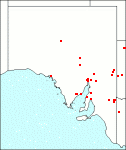Family: Asteraceae
Helianthus annuus
Citation:
L., Sp. Pl. 904 (1753).
Synonymy: Not Applicable Common name: Sunflower, common sunflower.
Description:
Annual herb 1-2 m high; stem erect, usually single from the base, often branched above, terete, hispid; leaves opposite near the base, alternate above, petiolate, ovate to triangular, cordate or truncate at the base, 3-20 cm long, 2-12 cm wide, entire to finely serrulate, scabrous to hispid, with 3 longitudinal veins.
Capitula few or 1 per plant, solitary, to 20 cm diam., turned to one side or nodding; involucral bracts numerous, ovate to lanceolate, long-acuminate, scabrous; receptacular scales 3-lobed, membranous; ligules elliptic, 2-3 cm long, bright yellow; disk florets numerous, brownish.
Achenes broadly curieate, flattened, unequally 4-angled, 5-10 mm long, black with grey streaks, finely pubescent; pappus scales 2, soon lost.
Published illustration:
Cunningham et al. (1982) Plants of western New South Wales, p. 680.
|
|
Distribution:
|
A locally common escape from cultivation on roadsides and around towns.
S.Aust.: LE, GT, FR, EA, EP, NL, MU, YP, SL. All mainland States. Native to North America.
|
Conservation status:
naturalised
Flowering time: Flowers; Nov. — May.
|

SA Distribution Map based
on current data relating to
specimens held in the
State Herbarium of South Australia
|
Biology:
No text
Uses:
Widely cultivated for the oil extracted from the seeds, and as an ornamental. The perennial Helianthus tuberosus, Jerusalem artichoke, is cultivated for its edible tubers and may persist in old gardens.
Author:
Not yet available
|

